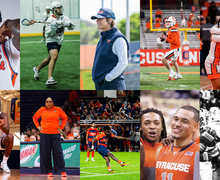Students react to Syracuse University’s switch to “YELLOW” masking level
Illustration by Yiwei He | Illustration Editor
The Daily Orange talked to about 100 students across SU’s campus about their reactions to the change. Here’s what they had to say.
Get the latest Syracuse news delivered right to your inbox.
Subscribe to our newsletter here.
On Monday, March 14, Syracuse University moved to a “YELLOW” COVID-19 masking level. Under the level, masks are no longer required for vaccinated individuals during academic instruction.
The Daily Orange talked to about 100 students across SU’s campus about their reactions to the change. Here’s what they had to say.
Many students said the downgrade to “YELLOW” level shows the pandemic is moving into the right direction. Vincenzo Suarez, a junior entrepreneurship and public relations major, said he felt relieved that SU is doing better.
“I know some people have seen it as like, ‘Oh, we’re not ready for that yet.’ But I see this as maybe it’s a sign that we are doing better and we’re getting better. So for me, I think it makes me feel optimistic and hopeful for the future,” Suarez said.
Meris Rosenberg, a junior in the College of Arts and Sciences, said while many of her professors chose to keep their masks on during instruction, most students in her classes don’t wear masks.
“It’s definitely weird, but I don’t mind it. It’s nice to see people’s faces again,” Rosenberg said. “At least for me, I’ve had the COVID shots. So I feel like it’s not that big of a risk.”
Ophelia DeStefano, a sophomore political science and education major, said it shouldn’t be a problem as long as the positivity rate on campus stays low.
“It also helps because some of the teachers I thought were more scary, and then they take their mask off and they’re smiling the whole class,” DeStefano said.
Some students said that while they appreciate the switch to a lower masking tier, they don’t think it makes a significant difference considering many students weren’t following mask-wearing guidelines before.
“I think it is just fine at this time (to not wear a mask) because even when the COVID mask level was at “RED,” I didn’t see everyone following those rules,” Sitao Wang, an engineering graduate student, said.
Some students noticed a positive social impact resulting from the change in masking level.
Law student Corrine Kalala shared that she appreciates the social aspect of optional masking, and noticed that she hasn’t seen tension or shaming between those who choose to wear a mask and those who choose not to.
Some students thought the university chose the wrong time to downgrade the masking level.
Liam Goff, a sophomore broadcast and digital journalism major, said, while it’s good that SU moved to the “YELLOW” level, switching the mask requirement immediately after spring break without testing lacks foresight. Andrea Sanchez, a junior policy studies and political science major, said she doesn’t agree with letting everyone go maskless immediately after spring break.
“I felt like maybe having a change immediately after spring break and going back to yellow and having everybody go maskless after everybody went to every different place in the world — I didn’t think that was the smartest idea,” Sanchez said. “But at the end of the day, I still wear my mask when I’m in classes because I want to feel protected. And hopefully the fact that we’re all boosted presumably evens it out.”
Sythong Run, a sophomore studying public health and environmental sustainability and policy, also expressed concerns on changing the mask level immediately after the spring break. Run said she’s still wearing masks to better protect herself and others, such as her roommate who has asthma.
Sandra Peña, a sophomore studying biochemistry and neuroscience, decided to study remotely for her freshman year because of the pandemic.
“It’s actually the college experience that I’ve been wanting, but then again, in the back of my mind, I’m always thinking it still isn’t the safest it could be,” Peña said. “I feel like the school (moved to “YELLOW” level) to say to the public … ‘We’ve gotten to the point where it’s safe enough,’ but we never know.”
Meanwhile, some students shared that they don’t fully trust SU’s decision when it comes to public health. Anely Vasquez, a freshman psychology major, said while people are happy about the policy change, she worries the positive cases will go up again.
Michele Garten, a sophomore studying advertising, said that whether she masks or not depends on the size of the class she’s in.
“Some (classes are) very spread out so I’m OK,” she said. “But then other classes, it’s super crowded and we’re basically shoulder to shoulder, so they can be uncomfortable sometimes.”
Goff also said while he feels comfortable not wearing masks in his classes that typically have less than 15 students, he would prefer to wear one in larger class settings.
“Sitting in there with a very small group of people in a relatively large space doesn’t bother me too much,” Goff said. “I would say that if I were in a lecture hall setting with maybe 150 (or) 200 students, I would probably prefer having a mask on.”
Some students said that, while they don’t personally feel safe enough to unmask in their classes, they don’t mind other students doing so.
Gabe Eggerling, a freshman studying architecture, said that he still is a little worried about the COVID-19 situation on campus and still chooses to mask wherever it’s recommended, but it doesn’t impact his view on the masking-level downgrade.
“I don’t think there’s a problem with there not being any mandates on anything,” he said. “I think if people don’t want to wear a mask right now, there’s no reason to have to wear a mask.”
Some students are comfortable with the decision to downgrade the masking level but feel like the level should only remain if cases stay low.
“I think they’re doing the best they can with what they have, and I would rather us have the option to not wear them than be forced to at this point,” Harlow Arcaro, a senior illustration major, said. “I feel that as long as the COVID numbers aren’t exploding on campus then I feel like we should have the option.”
Published on April 7, 2022 at 12:58 am






